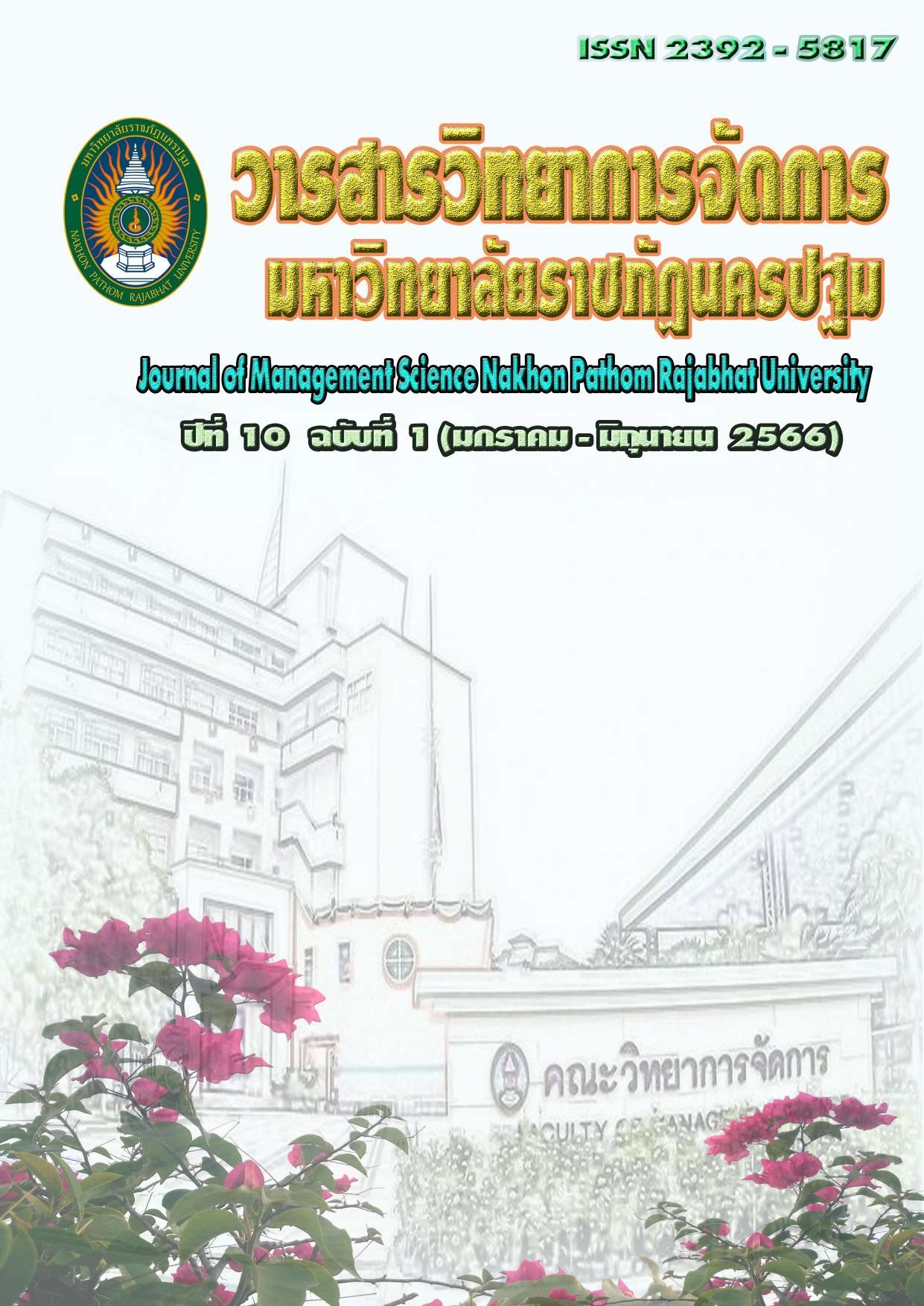Appropriate Assessment Criteria to the Prototype Area for Quality of Life According to the New Theory, Applied to the “Khok Nong Na Model”
Main Article Content
Abstract
The objectives of this research were 1) to study the factors of the prototype area for quality of life according to the New Theory, applied to the “Khok Nong Na Model”, and 2) to provide assessment criteria to the prototype area for quality of life according to the New Theory, applied to the “Khok Nong Na Model” and 3) study guidelines, problems and obstacles in the prototype area for quality of life according to the New Theory, applied to the “Khok Nong Na Model”This study used mix-method research. For the quantitative research, the sample group included 164 people. Data were collected by questionnaire and analyzed with descriptive statistics. For the qualitative research, 15 key informants, including Executives at department/province/district level responsible government officers, landlords and people in the area. The instruments were in-depth interview. Data ware analyzed by content analysis
The results revealed that the activities including 1) the factors of the prototype area for quality of life according to the New Theory, applied to the “Khok Nong Na Model” As for the overall criteria assessment results 4 consisting of social, knowledge, be it area and process it was at a high level (2) to provide assessment criteria to the prototype area for quality of life according to the New Theory, applied to the “Khok Nong Na Model” that is important consisting of 5 consisting 20 measure of Place, People, Product, Promotion and Management 3) guidelines, problems and obstacles in the prototype area for quality of life according to the New Theory, applied to the “Khok Nong Na Model to lack of knowledge don’t skilled personnel about area design. The impact of Natural Disasters including period of time inconsistent with the excavation period to complete. The suggestion is, there should be supervision, monitoring, and long-term Data support to develop and expand the activities in the area according to the social landscape for completeness and sustainability.
Article history: Received 27 November 2022
Revised 7 February 2023
Accepted 9 February 2023
SIMILARITY INDEX = 5.74 %
Article Details

This work is licensed under a Creative Commons Attribution-NonCommercial-NoDerivatives 4.0 International License.
The views and opinions of the article appearing in this journal are those of the author. It is not considered a view and responsibility of the editorial staff.
References
กรมการพัฒนาชุมชน. (2564). ชุดข้อมูลด้านการพัฒนาชุมชนและเศรษฐกิจฐานราก. [ออนไลน์].ค้นเมื่อ 30 เมษายน 2565 จาก https://data.go.th/blog/datasetcommunity
กรมการพัฒนาชุมชน. (2565).ร่างรายงานสรุปผลการดำเนินงาน โครงการพัฒนาพื้นที่ต้นแบบการพัฒนาคุณภาพชีวิตตามหลักทฤษฎีใหม่ ประยุกต์สู่ “โคก หนอง นาโมเดล”.กรุงเทพมหานคร: กรมการพัฒนาชุมชน
กรมทรัพยากรธรณี. (2562). ข้อมูลพื้นที่เสี่ยงภัยจากดินถล่ม น้ำป่าไหลหลากและน้ำท่วมฉับพลัน ประเทศไทย. กรุงเทพมหานคร: กองธรณีวิทยาสิ่งแวดล้อม.
คมสันต์ หุตะแพทย์. (2558). โคก หนอง นา โมเดล หยุดท่วม หยุดแล้ง นวัตกรรมจัดการน้ำสู้วิกฤติ. เกษตรกรรมธรรมชาติ.17(9). 25-28.
ณรัชช์อร ศรีทอง. (2556). แนวคิด หลักการและการปฏิบัติ ตามหลักปรัชญาของเศรษฐกิจพอเพียง. กรุงเทพมหานคร: โอเดียนสโตร์.
ปริยกร เพชรลำรุง (2558). ศูนย์เรียนรู้เศรษฐกิจพอเพียงกับการสร้างความเข้มแข็งให้กับชุมชน:ศึกษากรณี ศูนย์เรียนรู้เศรษฐกิจพอเพียงชุมชน ตำบลโมถ่าย อำเภอไชยา จังหวัดสุราษฎร์ธานี. กรุงเทพมหานคร: รายงานการวิจัย มหาวิทยาลัยรามคำแหง.
มาริษา ศรีษะแก้ว และสถาพร วิชัยรัมย์. (2563). เศรษฐกิจพอเพียง : แนวทางการพัฒนาอย่างยั่งยืน ในประเทศไทย. วารสารสหวิทยาการจัดการ คณะวิทยาการจัดการ มหาวิทยาลัยราชภัฏบุรีรัมย์. 4 (2).39-48.
รัตนะ บัวสนธ. (2556). การประเมินโครงการ:การวิจัยเชิงปริมาณ. กรุงเทพมหานคร: :คอมแพคปริ๊น.
รัฐพงศ์ สีแสด.(2556). การประเมินโครงการศูนย์การเรียนรู้เศรษฐกิจพอเพียงชุมชน กรณีศึกษษศูนย์เรียนรู้เศรษฐกิจพอเพียงชุมชนแห่งหนึ่งในภาคตะวันออก. กรุงเทพมหานคร:รายงานการวิจัย มหาวิทยาลัยเกษตรศาสตร์.
รัชนีวรรณ จีนธรรม, ปัณณ์รภัส ถกลภักดี และอรวรรณ ภัสสรศิริ. (2561). การพัฒนารูปแบบการจัดการเรียนรู้สิ่งแวดล้อมตามหลักปรัชญาของเศรษฐกิจพอเพียงของเครือข่ายกสิกรรมธรรมชาติ. วารสาร มจร พุทธปัญญาปริทรรศน์ มหาวิทยาลัยราชภัฏวไลยอลงกรณ์ในพระบรมราชูปถัมภ์. 3(2).238-248.
วิวัฒน์ ศัลยกำธร. (2558). โคก-หนอง-นา-โมเดล การสร้างวิถีชีวิตที่ยั่งยืน. [ออนไลน์].ค้นเมื่อ 28 เมษายน 2565 จาก http://lugean25042017.blogspot.com/2015/04/blog-post_6.html).
โศภิต นาสืบ. (2564). รายงานผลกระทบเชิงเศรษฐกิจและสังคมจากการระบาดของโรคโควิด-19 ในระดับโลก และในประเทศไทย. [ออนไลน์].ค้นเมื่อ 15 เมษายน 2565 จาก https://ddc.moph.go.th/
uploads/publish/1177420210915075055.pdf
ศิวราภรณ์ ไชยบุรี. (2555). ปัจจัยที่ส่งผลต่อความสำเร็จของศูนย์การเรียนรู้เศรษฐกิจพอเพียง ชุมชนบ้านทาป่าเปา ตำบลทาปลาดุก อำเภอแม่ทา จังหวัดลำพูน. ขอนแก่น: รายงานการวิจัย มหาวิทยาลัยขอนแก่น.
สำนักงานคณะกรรมการพิเศษเพื่อประสานงานโครงการอันเนื่องมาจากพระราชดำริ (สำนักงาน กปร.). (2552). เศรษฐกิจพอเพียงแนวคิดสู่การประยุกต์ใช้ที่ยั่งยืน. กรุงเทพมหานคร. บริษัท เอเชีย แปซิฟิค ออฟเซ็ท จำกัด.
สุกัญญา ดวงอุปมา ภัทราพร ภาระนาค และปารีณา แอนเดอร์สัน. (2558). การส่งเสริมและพัฒนาศักยภาพอย่างยั่งยืนของครัวเรือนเกษตรกรตามหลักปรัชญาของเศรษฐกิจพอเพียง : กรณีศึกษาบ้านโนนสง่า ตำบลหนองกุงจังหวัดกาฬสินธุ์. กาฬสินธุ์: รายงานการวิจัย มหาวิทยาลัยกาฬสินธุ์.
อภิชัย พันธเสน. (2557). เหลียวหลังเพื่อการขับเคลื่อนเศรษฐกิจพอเพียงในทศวรรษหน้า (2556 – 2565). กรุงเทพมหานคร: สำนักงานกองทุนสนับสนุนการวิจัย.
Stufflebeam, D.l.,(2002). CIPP evaluation model checklist: Atool for applying the fifth installment of the CIPP model to assess long-tern enterprises. Retrieved April 11, 2022 from http://www.wmich.edu/evalctr/checklist/cippcheck.htm.
Yamane, T. (1973). Statistics: An Introduction Analysis. New York: Harper International Edition.


